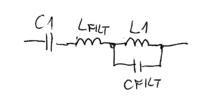pal114525
Member level 5
Hi,
Please see the attachment.
The attached circuit is a resonator driver circuit.
In this circuit simulation, I am using LTSpice.
I am getting the current through the inductor as sinusoidal. But, the voltage across the inductor is not sinusoidal in nature.
Is it a problem of the circuit or problem of the simulator?
Thanks & Regards.
Please see the attachment.
The attached circuit is a resonator driver circuit.
In this circuit simulation, I am using LTSpice.
I am getting the current through the inductor as sinusoidal. But, the voltage across the inductor is not sinusoidal in nature.
Is it a problem of the circuit or problem of the simulator?
Thanks & Regards.





